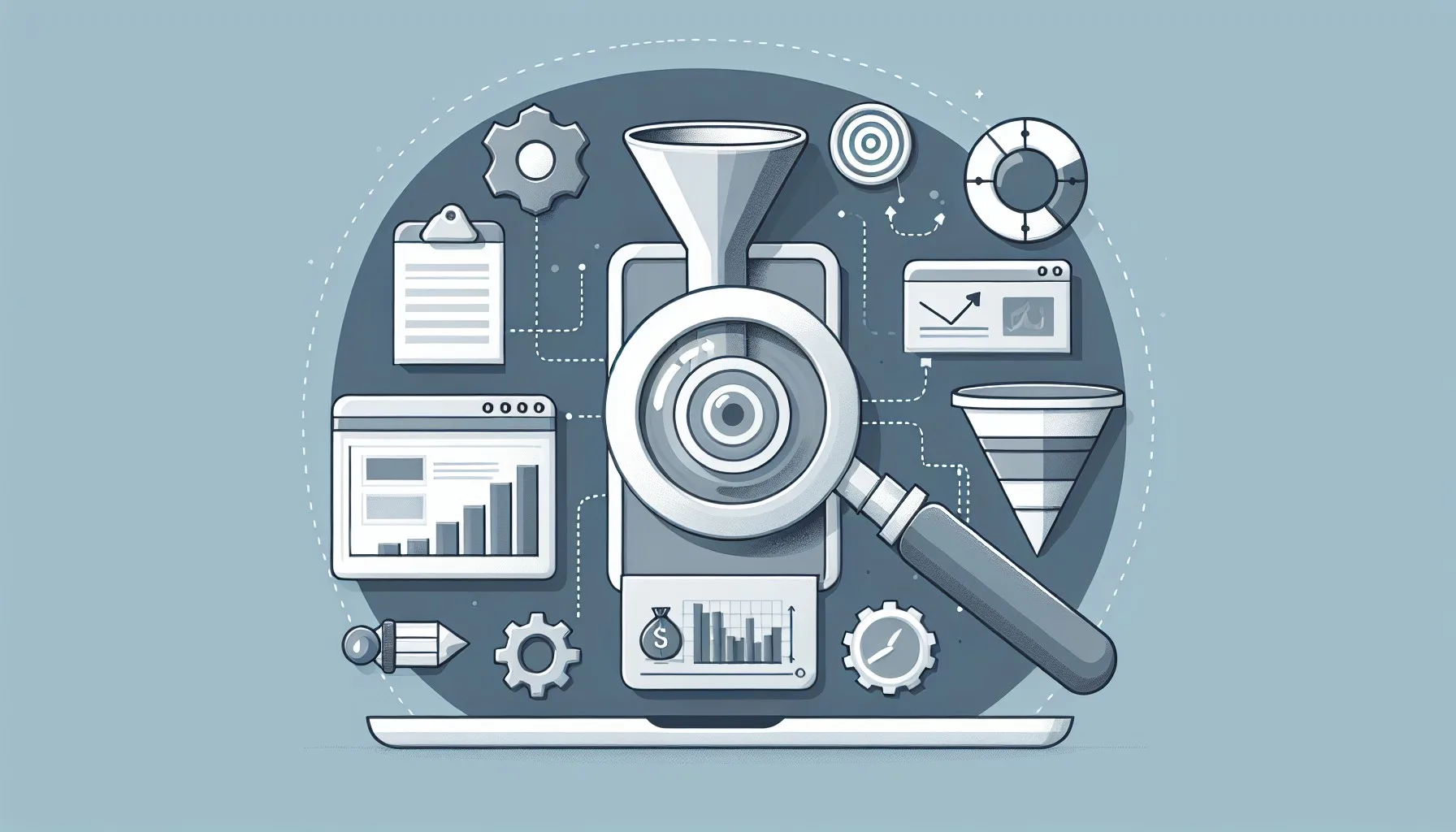Understanding Conversion Tracking
Getting the hang of conversion tracking is like finding the secret sauce to spice up your sales and marketing game. By knowing the different ways to track and why nailing that data is a game-changer, you’re setting up your business for some sweet wins.
Types of Conversion Tracking
Conversion tracking isn’t just one-size-fits-all. It changes up based on where your conversions happen—kind of like how you switch up your playlist for different moods. Here’s the lowdown on the usual suspects:
- E-commerce Conversions: Keeping tabs on what folks are buying from your site.
- Lead Generation Conversions: Watching who’s saying “Hey” with inquiries, sign-ups, or applications.
- Social Interactions: Noting down the likes, shares, and love your social media’s getting.
- App Downloads: Seeing how many swipes you get on your mobile apps.
- Call Tracking: Tracking those calls coming in from ads or your website.
Nailing these categories means you’re on top of what’s working best for your biz goals. Wanna dig deeper? Peek at our piece on rockstar conversion tracking tools.
Importance of Accurate Data
Getting your data right is like having a GPS when you’re driving. Without it, you’re just guessing. Strong data gives you the scoop on:
- Customer Moves: Watching how folks interact with your brand helps you tweak your marketing mojo.
- Campaign Feedback: Figure out which campaigns are the real MVP, so you know where to put your dollars.
- Money Matters: Good tracking makes sure you’re spending where it counts and getting those sweet returns.
Tools like Google Ads conversion tracking become your best buddies here, helping you keep tabs on what customers do, from buying stuff to signing up for newsletters or hitting that download button on your app (Google Ads Support).
Here’s a quick snapshot to see why good data rocks your world:
| Benefit | Description |
|---|---|
| Smart Moves | Good data means making savvy choices. |
| Better Campaigns | Check out what’s working and tweak to make it pop. |
| Stay Ahead | Use those insights to outsmart the competition. |
For more gems on crushing it with data, dive into our guides on conversion rate magic tools and data-fueled conversion boosts.
Challenges in Data Discrepancies
Facebook Ads vs. Google Analytics
If you’re a small biz owner trying to boost sales with digital marketing, you’ve probably pulled out a few hairs over data not adding up between Facebook and Google Analytics. One minute Facebook is singing your praises with 375 purchases and a shiny $20,596.30 in sales, then boom—Google Analytics swoops in reporting just 147 deals and a modest $7,179 in revenue. You gotta wonder where the truth lies, right? It’s like asking an honest answer from a compulsive two-faced friend.
So what gives? Turns out, both platforms have their own weird ways of counting conversions. Google Analytics waits till the last minute, giving credit to the final touch that pushed someone over the edge to buy. Meanwhile, Facebook plays Santa Claus, handing out credit to anyone who chimed in along the purchase journey. Such a different philosophy inevitably stirs up a numbers mix-up, leaving you scratching your head over which pal is tellin’ you the truth.
Oh, and don’t get me started on Facebook’s new guessing game with conversions, thanks to those iOS 14 privacy tweaks. Now it’s not just live data but shot-in-the-dark estimates, making the results a tad more foggy. All this confusion can really get in the way of figuring out your marketing mojo.
Impact of Data Discrepancies
Let’s be real—hoping for perfect data is a bit like wishing for rainbows every day. Aim to keep your data variations within a 20% margin, and you’re playing it cool. These variations can play havoc on your marketing moves, distort insights about your customers, and just mess with how you spill your ad dollars. See fewer purchases and lower revenue in Google than what Facebook shows, and you might downplay your ad’s glory, missing out on prime business growth.
Fixing troubles with attribution mix-ups, dodgy ad clicks, or sloppy tracking is key to getting your platforms to sing the same song. Hunting for ways to spiff up your conversion magic? Swing by our resources on affordable CRO solutions and professional CRO services to learn more. You’ll find some golden nuggets to polish your online game.
Strategies for Data Alignment
Want to level up your sales and marketing game? It’s time to focus on aligning the data you snag from all kinds of platforms. When you focus on keeping those data discrepancies in check and understand how attribution models work, you’re setting yourself up for success!
Maintaining Acceptable Discrepancy Ranges
Ever feel like your data from Facebook Ads and Google Analytics are speaking different languages? You’re not alone. You might see Facebook declaring 375 purchases adding up to $20,596.30, while Google Analytics barely counts 147 transactions worth $7,179. So, Facebook’s claiming 39% of the transactions and 35% of the bucks. Quite the head-scratcher, huh? It’s a typical puzzle for small business folks like yourself.
Aiming for flawless accuracy across platforms is like chasing unicorns. Instead, try to keep those numbers within a 20% range of each other. Here’s a little cheat sheet for ya:
| Platform | Purchases | Reported Revenue |
|---|---|---|
| Facebook Ads | 375 | $20,596.30 |
| Google Analytics | 147 | $7,179 |
| Discrepancy | 39% | 35% |
Fixing things like shady ad clicks and making sure tracking codes are behaving can help you hit that sweet spot. It’s all about getting a trustworthy picture of your marketing mojo so you can make savvy business choices.
Addressing Attribution Models
Get this: each platform’s got its own way of counting the beans. Understanding how they tick is key. Google Analytics plays by the last-click rule, dishing out credit to the last touchpoint before someone buys. Facebook, however, throws credit if it had any part in the show, no matter when! That’s why you might see some funky numbers from each spot (Lunio).
And with Facebook jumping into modeled conversions ’cause of those iOS14 privacy tweaks, things might get even crazier. Modeled conversions try to predict results rather than count them on the fly, adding another little twist (Lunio).
To iron this out, try syncing up your analytics tools! Platforms offering multi-channel attribution can piece together a clearer picture of your efforts. Need more scoop on what tools might work best? Check out our comparison of conversion tracking platforms. Getting your head around all this stuff will give your conversion tracking a boost, making it a lean, mean, marketing machine!
Utilizing Conversion Tracking Tools
Boosting your sales strategy with handy conversion tracking tools can really crank up your results. Among the crowd of options, Google Ads Conversion Tracking is like having a trusty sidekick, ready to lift your marketing game!
Google Ads Conversion Tracking
Alright, let’s break it down. Google Ads Conversion Tracking is a freebie that helps you spot those key actions by your customers. We’re talking purchases, signing up for your newsletter, giving you a ring, or snagging your app (Google Ads Support). It shows you how your campaigns are shaping up and where a little tweaking might work wonders.
With this tool, imagine sorting out what your customers do into neat little boxes. The actions might look like this:
| Type of Action | Description |
|---|---|
| Online Purchases | Folks buying your stuff online |
| App Downloads | People grabbing your app |
| Newsletter Sign-ups | Fans hopping onto your newsletter list |
| Phone Calls | Calls coming at ya from your advertisements |
Keeping tabs on these actions means you can fine-tune your strategy to pack more punch.
Setting Up Conversion Actions
Now, let’s get your conversion actions rolling with Google Ads. It’s not rocket science, but you gotta know what’s valuable to your biz. By dialing into this, you get the lowdown on how slick your ad strategy is.
Here’s your step-by-step to set up conversion actions:
- Get into Your Google Ads Account: Log in and hit the “Tools” icon.
- Pick ‘Conversions’: Under ‘Measurements,’ you’ll find ‘Conversions.’
- Create Conversion Action: Click the plus (+) and add that new conversion action.
- Decide on Action Source: Select ‘Website,’ ‘App,’ or ‘Phone calls’ – match it with what you’re tracking.
- Fill in the Details: Dish out the details like category, name, value, and count.
- Install the Tag: Google Ads will hand you a tag to pop into your site or app to start tracking.
Once your conversion actions are cooking, dive into your campaign data – ads, ad groups, keywords – to see the magic happen. Check how these tactics are fueling your business dreams.
For more flavor on top conversion tracking platforms, peek into other tools that suit your biz just right! Keep tinkering with your setup, and watch as customer excitement and your sales numbers shoot through the roof.
Enhancing Conversion Tracking
Want to see those sales numbers leap? Sprucing up your conversion tracking is like giving your piggy bank a magic boost. Add a pinch of social proof and nifty search engine tricks to stir up a customer experience that’s too irresistible to pass up.
Social Proof and Trust Building
Listen, no one’s buying if they don’t trust you. It’s just a fact of life—like pineapple on pizza splitting opinions. About three out of four folks reckon trust seals the deal when they’re choosing what to buy (HawkSEM). To sprinkle trust like confetti, nothing beats some good ol’ social proof. Fancy words, but it’s just about showing off happy campers through reviews, case studies, and what your customers are saying and doing. Not only does it make you look good, but it tells everybody else you’re the real deal.
How ’bout these social proof tactics to get those conversions flying?
| Social Proof Technique | Benefits |
|---|---|
| Customer Testimonials | Proves you’re the bee’s knees |
| Case Studies | Real-life success sagas to drool over |
| Influencer Endorsements | Borrow a bit of stardom trust |
Weaving social proof into your game plan can crank up those conversion numbers. Wanna dig deeper? Peek at our article about improving conversion funnel performance.
Search Engine Marketing Strategies
To get your conversion tracking jazzed up, you’ve gotta roll with slick search engine marketing (SEM) tactics. Let’s dive into some hotshot strategies:
- Unique Ad Copy: Make your ads pop—don’t blend in with the wallpaper.
- Create Urgency: Whip up some urgency. Time’s tickin’!
- Offer Deals: Flash some deals—everyone loves a bargain.
- Address Pain Points: Solve those pesky problems your customers face.
- Simplify Conversions: Roll out the red carpet for easy buying.
Hang tight before jumping in! Do a little detective work on keywords. Round up both your big-shot and long-tail keywords that pair perfectly with what your audience hunts for. Aim for those with peppy traffic but aren’t swarmed by rivals—it’s your ticket to top-ranking heaven (HawkSEM).
With these tricks up your sleeve, not only will you rev up your conversion tracking, but you’ll also be boosting sales like you’ve got cheat codes. Hungry for more insights? Check out our resources on customized conversion optimization solutions and effective conversion monitoring platforms.
Advanced Conversion Tracking Methods
Let’s talk turbo-charging your sales funnel and boosting business results. We’re diving into two main players: Google Analytics 4 conversion tracking and different models for keeping tabs on conversions.
Google Analytics 4 Conversion Tracking
First off, Google Analytics 4 (GA4) has given conversion tracking a whole new paint job. It’s now called Key Events, though Google Ads still knows ’em as conversions. This revamp? It’s all about making life easier for you—spotting and measuring those crucial user actions (Measureschool).
Tracking in GA4 is slick with Google Tag Manager (GTM) playing sidekick, offering boss-level tracking. GA4 comes with some neat features to snag all sorts of conversions, giving you a flexible approach to dig into precious insights.
GA4 also brings in fresh tools for tracking conversions:
| Feature | What’s the Deal? |
|---|---|
| Enhanced Measurement | Automatically picks up on stuff like scrolls, clicks to elsewhere, site searches, and video engagement. No code needed! |
| Custom Events | Create events with up to 25 nitty-gritty details for next-level tracking. |
| Predefined Events | Handy pre-set events for common interactions make data collection a breeze. |
These tools mean you can dive into your data like never before. Implement these GA4 goodies and watch your data-backed decisions level up your marketing game like never before.
Models for Tracking Conversions
Now onto the game plans for tracking conversions in GA4 that add clarity to your conversion approach. Let’s chew the fat on two heavy hitters: Micro and Macro Conversions Models and the Marketing Funnel Conversions Models.
- Micro and Macro Conversions Models
- Micro Conversions: Tiny steps that march towards the big goal (think signing up for a newsletter or loading up a cart).
- Macro Conversions: The holy grail—finishing a purchase or signing up for a service.
- Marketing Funnel Conversions Models
This model splits into different funnel vibes:
- Awareness: Getting folks to notice your brand.
- Consideration: Sparking interest in your cool stuff.
- Conversion: Sealing the deal where lookers turn into customers.
Nailing these models means you’ll spot user quirks and polish up your strategies. Knowing each stage and what users do gives you the edge, letting you tweak your strategy to turn more looky-loos into buyers.
For more legendary strategies on conversion optimization, check out our tailored conversion optimization resources and rock-solid CRO methods. Mastering conversion tracking plants power in your hands, tweaking your marketing approach, and surfacing some seriously better business results.




